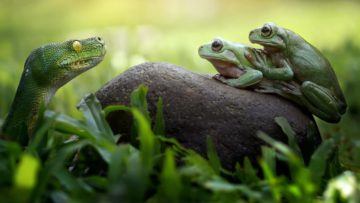Veronique Greenwood in Quanta Magazine:
 Perched on a leaf in the rainforest, the tiny golden mantella frog harbors a secret. It shares that secret with the fork-tongued frog, the reed frog and myriad other frogs in the hills and forests of the island nation of Madagascar, as well as with the boas and other snakes that prey on them. On this island, many of whose animal species occur nowhere else, geneticists recently made a surprising discovery: Sprinkled through the genomes of the frogs is a gene, BovB, that seemingly came from snakes.
Perched on a leaf in the rainforest, the tiny golden mantella frog harbors a secret. It shares that secret with the fork-tongued frog, the reed frog and myriad other frogs in the hills and forests of the island nation of Madagascar, as well as with the boas and other snakes that prey on them. On this island, many of whose animal species occur nowhere else, geneticists recently made a surprising discovery: Sprinkled through the genomes of the frogs is a gene, BovB, that seemingly came from snakes.
After poring over genomes from frog and snake species around the world, the scientists reported in April in a paper in Molecular Biology and Evolution that this gene has somehow traveled from snakes to frogs at least 50 times all over the planet. But in Madagascar it has inserted itself into frogs with startling promiscuity: 91% of the frog species sampled there have it. Something seems to make Madagascar an exceptionally conducive place for the gene to get mobile. When Atsushi Kurabayashi, an associate professor at the Nagahama Institute of Bio-Science and Technology and the senior author of the new paper, first saw the snake version of the gene in frogs, he was puzzled. He asked a colleague who specializes in genomics about it, and the colleague immediately shouted, “It must be horizontal transfer!” — the transfer of a gene from one species to another, in contrast to the vertical inheritance of genes by a child from a parent.
More here.
